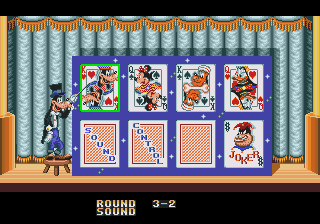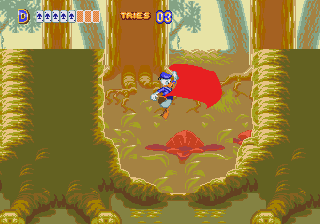This page details one or more prototype versions of World of Illusion Starring Mickey Mouse and Donald Duck.
| To do:
BBS group "MAGICAL" distributed this ROM? If so, then this should be indicated in the text, and not written off as a riddle. Check the information, and rewrite the subtitle of the page.
- At the end of 2019, a similar prototype appeared. Explore the differences between the two prototypes, if possible.
|
The origins of this World of Illusion prototype are a bit mysterious. It's one of those 16-bit prototypes that's been around for so long that it's not clear who dumped the cart, or when it was originally dumped. It seems to be a build of the game from around the time of the 1992 Summer Consumer Electronics Show, though with the number of debug features present it doesn't seem to be that exact build.
The date in the ROM header is September 1992, compared to October 1992 in the final game. This is almost definitely a projected game completion date rather than the actual build date, which would be some point around June 1992.
Round Differences
Differences that aren't square.
Intro / Prologue
- The first difference can be heard as soon as the game starts. For the SEGA logo and Illusion Shot Pictures screens, the prototype plays a version of the Walt Disney Pictures "Blue castle" theme heard in many of Disney's 80s and 90s releases. The final version plays no music at all.
- The prototype fades out after the song ends, which takes about 15 seconds. In the final game, the fade out only takes 9 seconds.
| Prototype |
|---|
 |
| Final |
 |
- In the intro's foreground layer, there are many more duplicated tiles in the final version. Note that the cane holding up the top hat and the rim around the barrel are only complete in the prototype version of the game. Those tiles were likely removed to make room for new graphics needed for the final version.
| Prototype |
|---|
 |
| Final |
 |
- Again the prototype version has more detail than the final version. In this case, most of the graphics that were deleted are at the bottom of the screen, which is obscured by the foreground layer anyway, as are the dresser and box at the far left.
| Prototype |
|---|
 |
| Final |
 |
- The drawer that was deleted from the previous background layer is appropriately redrawn to match the new perspective in the prototype, though obviously this wasn't needed in the final version. The magic box is completely visible in the prototype; It was moved behind a pile of boxes (Which was also simplified) in the final game. The brick wall also extends out further in the prototype.
| Prototype |
Final |
|---|
 |
 |
- Even poor Goofy has his graphics trimmed for the final game. He went from a three frame animation of worryingly looking at his watch, to a two frame animation of carrying props across the stage.
| Prototype |
Final |
|---|
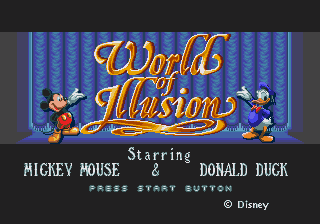 |
 |
- The time taken from the initial dissolve to the title screen background to the "Press Start Button" graphic appearing is about five seconds shorter in the prototype version, causing the intro music to go out of sync.
- Both Mickey and Donald look pretty wonky on the prototype's title screen. Donald's hand was redrawn and highlights were added to his eyes, while the Mickey sprite looks completely new.
- The copyright information was expanded to include the year and a second SEGA copyright.
- There are no gameplay demos in the prototype.
| Prototype |
|---|
 |
| Final |
 |
- All of the pictures in the prologue are in sepia tones in the prototype! All sprites are larger in the final version, while the backgrounds were mostly left alone.
- Donald has a shadow in the second and third prototype pictures. For some reason, this detail was removed in the final game.
- The robed figure looks considerably less sinister in the prototype.
Main Menu
| Prototype |
Final |
|---|
 |
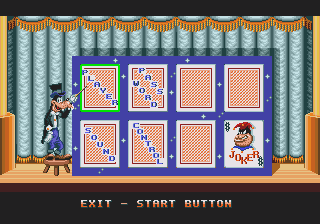 |
- The Password and Player cards were swapped in the final version.
- The starting round & stage numbers and current sound test ID are displayed below the stage.
- The black below the stage was changed to a very dark grey color to properly blend with the font palette.
- Passwords haven't actually been implemented yet - the password screen acts as a stage select instead. The first card controls the Round number, and the second and third cards control the stage number. The fourth card doesn't do anything yet.
- The game won't remember the current player setup if you go back to the player select menu again. So, if you chose Donald and went back into the menu, the cursor would default to Mickey and you'd have to select Donald again.
- The sound test also plays sound effects in the prototype. In the final version, it only plays music and voice clips.
- Exiting the sound test will not reset the sound test counter as it does in the final version.
Ending
| Prototype |
Final |
|---|
 |
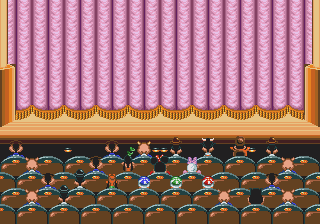 |
The final version added the rising curtain, Pete (lower-right), and about 15 generic seat fillers to the magic show. The prototype always uses what would become Mickey's ending in the prototype; The final version adds two more endings for clearing the game as Donald and in 2P mode.
Gameplay Differences
| Prototype |
Final |
|---|
 |
 |
- The default player is Donald in the prototype and Mickey in the final game.
- An important change in controls:
- In the prototype, players swing their capes with the Attack button, run by holding the Attack button, and perform round-specific magic tricks with the Magic button.
- In the final game, players swing their capes with the Attack button, run by holding the Run button, and perform round-specific magic tricks by pressing any of the three action buttons.
- Several debugging features are enabled by default:
- Mickey and Donald are invincible, though insta-death hazards like pits and the running water in Round 2-D will still cause the player to lose a try.
- Pressing the Start Button toggles a simple free-movement mode.
- Holding the A Button and pressing Start sends the player back to the main menu.
- All of the cards, health pick-ups, and other items that are abundant in the final version are completely absent in the prototype version. In fact, they haven't even been drawn or coded yet!
- Players can't swing their capes while ducking in the prototype version.
- Players start with 10 tries in 2P mode in the prototype. This was reduced to 6 tries in the final game.
- Players can't stun each other with their capes in 2P mode yet.
- Hoisting a player up in 2P mode is twice as slow in the prototype game.
- The game will frequently freeze if one of the players dies in 2P mode. This seems to be a bug with trying to find a respawn point for the revived player.
- The Game Over screen will always display the password for Round 1, regardless of the players' progress.
Graphical Differences
Both Mickey and Donald's sprites were polished in the final version. The following changes keep the characters closer to their official models, and applies to almost every single frame of animation:
- Both character's torsos are thicker.
- Mickey's ears now maintain a consistent shape between animations.
- Mickey's ears stay closer to the center of his head.
- The buttons on Mickey's overalls look shinier.
- Donald now has his signature red bow tie.
- The white trim around Donald's neckline is now yellow, and yellow trim has been added to his shirt cuffs.
- Donald's feet are fatter and use less complicated shading.
Interestingly, the final version's cutscenes still use the prototype player sprites! It seems that SEGA made the choice to redo the storybook pictures in full color before the character designs were updated.
| Prototype
|
Final Game
|
Comments
|
 
|
 
|
In the prototype, the first frame of Mickey's idle animation has his head turned backwards, which can kinda mess with the player's perspective. This was fixed in the final version, and the idle animation was redone so that he looks back twice before getting into a more relaxed pose.
|
 
|
 
|
Mickey is again glancing back in the prototype, looking much more nervous than he should. He's glancing upwards in the final game.
|
|
|
|
The magic capes are monochromatic in the prototype version, though the actual shape of the capes are identical between versions.
|
|
|
|
The cape swinging animation was shortened from 50 frames in the prototype to 38 frames in the final version, leaving players less vulnerable to enemy attacks and speeding up play time.
|
 
|
 
|
When Mickey and Donald land after jumping in the prototype version, they very briefly go into their falling animations. This was fixed in the final game.
|
 
|
 
|
Mickey's ears go all over the place while looking around in the prototype version, while they stay closer to the center of his head in the final game. The shivering effect around Donald no longer extends below his belly in the final version.
|
 
|
 
|
Mickey and Donald can't actually take damage in the prototype, but the animations are already in the game.
|
|
|
|
These two hit frames aren't used in the prototype or final game, but they were touched up regardless.
|
|
|
|
Donald no longer has an overbite in his pitfall animation in the final version.
|
|
|
|
In Mickey's dazed animation, Mickey's hands are in a different, more hilarious position in the prototype.
|
|
|
|
Mickey and Donald's palettes are incorrect in the prototype version. This only affects Mickey's cloth color, but Donald has an additional coloring error with his yellow bill.
|
 
|
N/A
|
These animations, used when one player has lost a try and has to wait for the other player to come along, are only in the prototype version. The final game just reuses the dazed animations, though a version of Mickey's sprite does show up in one of the prologue pictures as seen above.
|
Unused Graphics
These graphics are unused even in the prototype. They're nowhere to be found in the final game, having been deleted to make room for new graphics.
| Graphics
|
Comments
|
 
|
Stationary balancing sprites for Mickey and Donald. They're always moving in the prototype and final game.
|

|
A strange animation of a despondent Donald trying to fly, similar to his removed waiting sprite.
|
|
|
A water lotus that's loaded during Round 2-D. This was presumably replaced by the pile of pink leaves seen in the final game.
|
|
|
The water lotus would split into these parts when hit by Donald.
|
|
|
An extra layer of parallax scrolling for Round 3-D. There's not enough vertical space on the screen for this layer, though.
|
 
|
Graphics for a "CAR" enemy that matches the style of the Round 4-D enemies seen in the final game.
|
 
|
Another Round 4-D type object. It's a "BOMB" flag that explodes, as bomb flags are wont to do.
|
|
|
Special pressed variants of the dice seen in Round 5-1. In the final game, these graphics were deleted, and they just sink into the ground.
|

|
A "COMING SOON" banner. This was presumably used in the actual Summer CES build, but it's unused in this version.
This is not the correct palette for this object; The palette seen here is based on the font seen in the Game Over screen.
|
Audio Differences
Music
| Track
|
Proto
|
Final
|
Comments
|
| Intro
|
|
|
Very obvious placeholder instruments are used in the prototype version, but otherwise the song is the same.
|
| Round 1-1
|
|
|
The prototype track is about 10% slower than the final track. The final game adds another 17 seconds worth of music to the end of the track.
|
| Round 1-2
|
|
|
The final track is very slightly faster, fixes the instrument choice of the prototype, and, again, is 17 seconds longer.
|
| Round 2-1
|
|
|
In addition to more appropriate instruments, an 8 second intro and 8 second outro were added to the final track.
|
| Round 2-M
|
|
|
Though the main melody is the same, the individual sound channels are very different between versions.
|
| Round 2-D
|
|
|
The prototype track is 5% slower than the final track. That's all, really.
|
| Round 3-D
|
|
|
The prototype uses a version of the Round 3-2 song with seemingly inverted volume levels to temporarily fill this slot.
|
| Round 3-2
|
|
|
Yet more strange instrument choices in the prototype version.
|
| Round 4-1
|
|
|
Same melody, same tempo, different instruments. Yes.
|
| Round 4-M
|
|
|
This track is mostly the same but for the backing instruments at the end changing.
|
| Round 4-P
|
|
|
Instrument changes again, and the prototype track has a less spectacular ending. The final game's track is two seconds longer.
|
| Round 5-1
|
|
|
A few instruments were altered to be less ear-piercing.
|
| Round 5-M
|
|
|
Volume adjusted on two channels at the end of the track.
|
| Round 5-P
|
|
|
Instrument changes. Note that this track is also used for Round 5-2 in the prototype, which has its own track in the final game.
|
| Boss
|
|
|
Instrument changes. Boss instrument changes.
|
| Round Clear
|
|
|
Last of the instrument changes.
|
| Game Over
|
|
|
The percussion section is barely audible in the prototype version.
|
Sounds
Though these sounds aren't actually used in the prototype, they can be heard in the sound test. They differ so much from the final sounds that they probably weren't even intended for the same purpose.
| Track
|
Proto
|
Final
|
| A2
|
|
|
| A3
|
|
|
| A7
|
|
|
| A9
|
|
|
| AD
|
|
|
| AE
|
|
|
Voices
Tony Anselmo thankfully re-recorded these low-quality Donald samples.
| Voice
|
Proto
|
Final
|
| Donald: "Alakazam!"
|
|
|
| Donald: "Wow!"
|
|
|
Text Differences
Cutscenes
All cutscene text is in the game, though the Box Magic and Card Magic text can't normally be seen in the prototype. The text is in a pretty unpolished state at this point, though it's not as poorly written as the unused draft seen in the prototype and final ROMs.
| Context
|
Proto
|
Final
|
| Intro
|
“Uh, I don't know if that's such
a good idea...” returned Mickey,
noticing a strange glow behind
the curtain.
Mickey stepped inside to
inspect the box and Poof!,
he disappeared too.
|
“Uh, I don't know if that's such
a good idea...” replied Mickey,
noticing a strange glow behind
the curtain.
Mickey stepped inside to
inspect the box and...Poof!,
he disappeared too.
|
| Carpet Magic
|
Inside the chest, there is an
ancient manuscript. It describes the
great magic.
“. . . If you say magic word,
’ALAKAZAM’and press A button, a
flying carpet will appear.
It is easy to control: hold down C
Button to fly up. If you don't press
C button, your carpet will come back
to the ground. ”
|
Inside the chest, there is an
ancient manuscript describing great
magic.
“If you say the magic word,
’ALAKAZAM’, and then press any one
of the buttons, a flying carpet
will appear.
To control the carpet, hold down
the JUMP button to fly up. If JUMP
is not pressed, the carpet will
descend.
Use the direction pad to control
your movement.”
|
| Bubble Magic
|
“. . . If you say magic word,
’ALAKAZAM’and press A button, a
magic bubble will appear.
It is easy to control: hold down C
Button to float up when you are in
water, and use D button to control
your direction.
If you don't press C button, you and
your bubble will sink down.”
|
Inside the chest, there is an
ancient manuscript describing great
magic.
“If you say the magic word,
’ALAKAZAM’, and then press any one
of the buttons, a magic bubble
will appear.
To control the bubble, hold down
the JUMP button to float up, and use
the direction pad to control your
movement.
If JUMP is not pressed, the bubble
will sink.”
|
| Box Magic
|
“. . . Say ’ALAKAZAM’and press A
button, then you can warp another
box.”
|
Inside the chest, there is an
ancient manuscript describing great
magic.
“If you say ’ALAKAZAM’, and then
press any one of the buttons, you'll
be transported to another box.”
|
| Card Magic
|
“. . . If you say magic word,
’ALAKAZAM’and press A button, you
can command cards.”
|
Inside the chest, there is an
ancient manuscript describing great
magic.
“If you say ’ALAKAZAM’, and then
press any one of the buttons, you'll
be able to command cards.”
|
In-Level Dialogue
Even though none of the in-level dialogue triggers are present in the prototype, most of the text is in the ROM. All of the text differs significantly from the final draft.
| Context
|
Proto
|
Final
|
| Carpet Magic
|
“ IT LOOKS LIKE NOW
IS THE TIME TO TRY
THAT NEW MAGIC.”
|
“ THIS LOOKS LIKE A
GOOD TIME TO TRY OUT
THAT NEW MAGIC.”
|
| Bubble Magic (1P)
|
“I'LL NEVER KNOW IF
I DON'T GIVE IT A
TRY. DO IT!”
|
“HERE GOES NOTHING!”
|
| Bubble Magic (2P)
|
MICKEY:“DO YOU REALLY
THINK THIS MAGIC
TRICK WILL
WORK?”
DONALD:“WE'LL NEVER KNOW
IF WE DON'T GIVE
IT A TRY.
LET'S DO IT!”
|
MICKEY:“GOSH, I REALLY
HOPE THIS NEW
TRICK WORKS...”
DONALD:“WE'LL NEVER KNOW
'TIL WE TRY!”
|
| Door Magic (1P)
|
N/A
|
“I THINK MY NEW TRICK
WILL COME IN HANDY
NOW.”
|
| Door Magic (2P)
|
“THIS LOOKS LIKE A GOOD
TIME TO USE THAT NEW
MAGIC TRICK.”
|
“I THINK OUR NEW TRICK
WILL COME IN HANDY
NOW.”
|
| Card Magic (1P)
|
N/A
|
“THIS MUST BE WHERE
I CAN USE MY NEW
MAGIC!”
|
| Card Magic (2P)
|
“THIS LOOKS LIKE THE
TIME TO TRY OUT THAT
NEW MAGIC.”
|
“THIS MUST BE WHERE
WE CAN USE OUR NEW
MAGIC!”
|
| Final Boss Intro
|
“YOU HAVE DONE WELL TO HAVE
MADE IT SO FAR, BUT YOUR
FATE ENDS HERE - YOU CAN
NEVER ESCAPE!”
|
“YOU HAVE DONE WELL SO FAR,
BUT YOUR ADVENTURE ENDS
HERE! YOU'LL NEVER DEFEAT
ME!”
|
| Final Boss Beaten (1P)
|
N/A
|
“AMAZING! NO ONE HAS EVER
DEFEATED ME! YOU ARE A GREAT
MAGICIAN! AS I PROMISED,
I'LL SHOW YOU MY GREATEST
TRICK: HOW TO ESCAPE FROM
MY WORLD OF ILLUSION.”
|
| Final Boss Beaten (2P)
|
“I DON'T WANT TO DO THIS,
BUT I WILL TEACH YOU THE
WORLD'S GREATEST MAGIC
TRICK.”
|
“AMAZING! NO ONE HAS EVER
DEFEATED ME! YOU ARE GREAT
MAGICIANS! AS I PROMISED,
I'LL SHOW YOU MY GREATEST
TRICK: HOW TO ESCAPE FROM
MY WORLD OF ILLUSION.”
|
Other Unused Text
| Address
|
Text
|
Notes
|
| 0x1D78B
|
CONFIGLATION
ROUND NO
RESTART NO
|
Text for a much more primitive configuration menu.
|
| 0x1E31B
|
NOW PROGRAMING
|
Generic placeholder message that's not needed anywhere in this build.
|
















